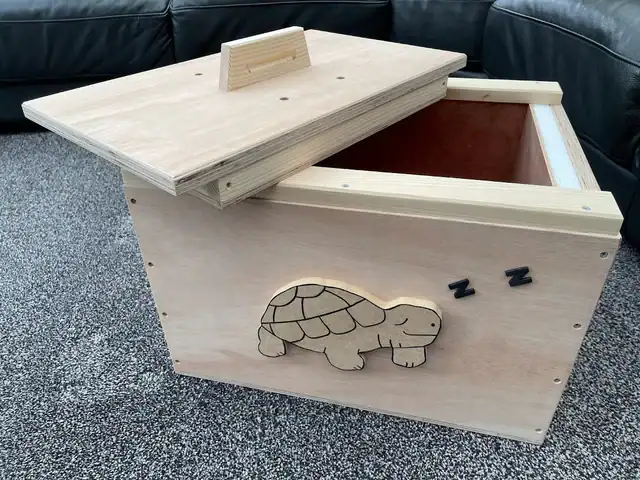Creating a safe haven for your tortoise during those chilly months is key to ensuring their health and happiness. An insulated structure helps maintain a stable environment, mimicking the natural conditions they thrive in.
This is where a well-built hibernation habitat comes into play.
When constructing your reptile box, it’s vital to choose materials that provide durability and effective insulation.
You want to ensure your tortoise is shielded from the elements and any potential predators. A cozy and secure outdoor enclosure is not just a luxury; it’s a necessity for your shelled friend’s well-being.
| Step | Action | Details / Materials Needed | Tips |
|---|---|---|---|
| 1. Choose Outer Box | Select a sturdy container | Wooden crate, thick cardboard, or plastic tub | Should be at least 2× tortoise length in all directions |
| 2. Create Inner Box | Insert a smaller box inside the outer one | Use wood/cardboard box slightly larger than tortoise | Leaves space between for insulation |
| 3. Add Insulation Layer | Fill gap between inner & outer box | Shredded paper, polystyrene, hay, straw, or foam board | Ensures stable temp (4–8°C / 39–46°F) |
| 4. Prepare Bedding | Line inner box | Soil, shredded paper, sand/soil mix, or sterilized topsoil | Depth: enough for tortoise to partially burrow (~10–15 cm) |
| 5. Ventilation | Drill small holes in outer and inner box | 3–4 holes per side, pencil-sized | Prevents stale air, but keep holes small to avoid drafts |
| 6. Secure Lid | Close box with a firm, breathable cover | Wooden/plastic lid with extra air holes | Protects from predators if outdoors |
| 7. Temperature Monitoring | Place thermometer probe inside | Digital thermometer/hygrometer | Maintain stable 4–8°C with 50–70% humidity |
| 8. Trial Run | Test before use | Place box in shed, garage, or fridge method for a week | Ensure temp doesn’t fluctuate widely |
| 9. Place Tortoise In | Introduce only after pre-brumation prep | Tortoise should have fasted & been hydrated | Always check weight & health first |
| 10. Weekly Checks | Inspect during brumation | Weigh tortoise, check for signs of illness/dehydration | Safe weight loss: <1% per mo |
Choosing The Right Tortoise Shelter
Creating a cozy spot for your tortoise is key to ensuring they thrive. A thoughtfully designed space not only establishes a secure environment but also helps maintain an ideal temperature control and moisture level.
When you’re picking out a shelter, think about your tortoise’s size and natural habits.
They should have ample room to roam, especially during their hibernation period.
Plus, choosing the right bedding material can make a world of difference, offering comfort and warmth as they settle in for a snooze.
Keep in mind, each tortoise has its own unique needs, so it’s wise to adjust your setup based on their specific preferences. Effective temperature control, humidity regulation, and secure environment are essential for maintaining the ideal conditions during the hibernation period, particularly concerning the choice of bedding material.
Understanding Hibernation Habitat Needs
Creating the perfect resting place for your tortoise can significantly influence its overall health and well-being. A comfortable environment does more than just help with hibernation; it ties in closely with what you’ve discovered about selecting the right shelter.
Ensuring your tortoise feels safe and cozy begins with a secure space that minimizes disturbances and guards against predators.
Wooden housing presents a great option, providing natural resources for insulation and a familiar atmosphere.
Having ventilation openings is equally important, as they allow fresh air to circulate while keeping the humidity levels appropriate for proper tortoise care.
It’s also important to pay attention to moisture levels in the habitat. Excessive dampness can lead to various health problems, so having a proper drainage system is key. Keeping the environment sustainable requires careful management of natural resources, the promotion of wooden housing with ventilation openings, the responsible care of tortoises, and a commitment to wildlife conservation.
- Wooden housing provides natural insulation and a familiar environment for tortoises.
- Proper ventilation openings are essential for maintaining appropriate humidity levels and air circulation.
- Excessive moisture can lead to health issues, making a good drainage system crucial for tortoise habitats.
- Responsible management of natural resources contributes to the sustainability of tortoise care and wildlife conservation.
Importance Of Temperature Control
Creating a comfortable environment for your tortoise is more important than you might think. Since they are ectothermic creatures, their body temperature is entirely influenced by their surroundings.
If temperatures swing to extremes, it can slow down their metabolism, leading to some serious health concerns.
Seasonal adaptation plays a huge role here; during the colder months, arranging a hibernation chamber helps them rest safely.
When they’re active, temperature affects their eating habits and overall behavior, making shelter design a key factor. By keeping a close eye on their environment and making necessary adjustments, you ensure their tortoise safety and well-being throughout the year
How To Ensure Humidity Regulation?
Creating a comfortable space for your tortoise is key to their well-being. Every species has its own unique preferences when it comes to moisture levels, making it important to understand your specific tortoise’s needs.
A hygrometer is a handy tool for checking these levels regularly, ensuring the habitat stays just right.
For many tortoises, maintaining humidity between 40% to 70% is ideal for promoting overall health.
Insulated walls can help maintain a consistent environment, protecting against fluctuations outside. It’s also a good idea to keep an eye on climate control factors, as they can significantly impact your setup.
Now that we’ve covered this aspect, let’s transition into creating a secure environment for your treasured wildlife housing
| Humidity Level | Ideal Range |
|---|---|
| Moisture Levels | 40% to 70% |
| Insulated Walls | Helps maintain a consistent environment |
| Climate Control Factors | Significantly impact habitat setup |
Creating A Secure Environment For Tortoises
Providing a cozy haven for your tortoise can make a world of difference in their daily life. These gentle creatures really do thrive when they feel safe from predators and harsh weather conditions.
When setting up their home, whether indoors or outdoors, it’s important to create an escapeproof area that allows them to feel secure.
For outdoor habitats, incorporating natural elements like shrubs and rocks not only provides shelter but also taps into their hibernation instincts.
Don’t forget to include deep bedding that encourages tortoise burrowing, giving them that snug, protected feeling they crave. A well-thought-out environment significantly enhances their overall well-being, leading to a happier, healthier tortoise
Selecting Suitable Bedding Material
Choosing the right materials for your tortoise’s living space can significantly impact their overall happiness and well-being. A suitable substrate contributes to moisture retention, temperature regulation, and animal welfare.
Among the popular options are coconut coir, aspen shavings, and straw, each offering distinct advantages and disadvantages.
For example, coconut coir excels in retaining moisture, which is beneficial for maintaining a healthy environment, while aspen shavings are known for their easy cleanup.
It’s essential to consider potential allergens and how seasonal changes might alter your selection. A well-maintained protective enclosure not only enhances your tortoise’s comfort but also supports their natural hibernation patterns. Transitioning from providing comfort to creating a secure living environment is crucial, ensuring that the substrate supports natural hibernation, promotes moisture retention, and provides a protective enclosure for optimal animal welfare.
Tortoise Living Spaces
- Coconut coir retains moisture effectively, promoting a healthy environment for tortoises.
- Aspen shavings offer easy cleanup, making maintenance simpler for caretakers.
- Choosing hypoallergenic materials can minimize health risks for tortoises.
- A well-maintained enclosure supports natural hibernation patterns, enhancing overall animal welfare.
Tips For Effective Shelter Design
Designing a cozy retreat for your tortoise can be a fun adventure! Start by exploring your pet’s natural environment; this knowledge shapes how you approach their outdoor reptile space. A generous area allows them to roam freely, which is key to their happiness.
When choosing materials, go for ecofriendly materials that not only last but also provide comfort.
Don’t overlook the importance of ventilation; good airflow is crucial in preventing moisture build-up, which can lead to unpleasant conditions.
Also, having a secure lid is a smart way to protect your little friend from any potential predators. Keep an eye on how they use their shelter, and feel free to make adjustments based on their behavior
Maintaining Tortoise Health During Hibernation
As your tortoise prepares for its seasonal sleep, there are several ways to ensure it stays healthy and comfortable. Start by creating a hibernation area that mimics natural conditions.
It’s all about the right temperature and humidity, which plays a significant role in their well-being.
For winter care, consider insulation methods to maintain a stable environment, helping them feel secure throughout their rest.
Make sure to provide a cozy bedding layer, like hay or leaves, where they can nest. Keep an eye on their activity levels and appetite beforehand; healthy tortoises will show signs of readiness.
Understanding their species-specific needs during this time is crucial, as each type of tortoise has unique requirements to thrive. Transitioning from the tips for effective shelter design, this focus on their comfort considers winter care, species-specific needs, insulation methods, and the hibernation cycle to promote a wildlife-friendly design.
Tortoise Hibernation
- Proper temperature and humidity levels are essential for a tortoise’s health during hibernation.
- Insulation methods can help maintain a stable environment, reducing stress for the tortoise.
- Providing appropriate bedding, such as hay or leaves, allows tortoises to create a comfortable nesting area.
- Each tortoise species has unique hibernation requirements that must be understood for their well-being.
Conclusion
Caring for your shelled friend during their hibernation period can feel like quite an undertaking. With a bit of planning and awareness, you can transform their space into a cozy retreat.
Each tortoise species has specific habitat simulation needs to keep them comfortable, so tailoring their environment is key.
A thoughtful setup will not only support their well-being but also positively influence their behavior as they rest.
Have you considered the optimal conditions to help your tortoise thrive? Addressing these important details will go a long way in ensuring your tortoise remains healthy and happy during their dormant state.
Originally posted 2025-02-12 08:18:23.



